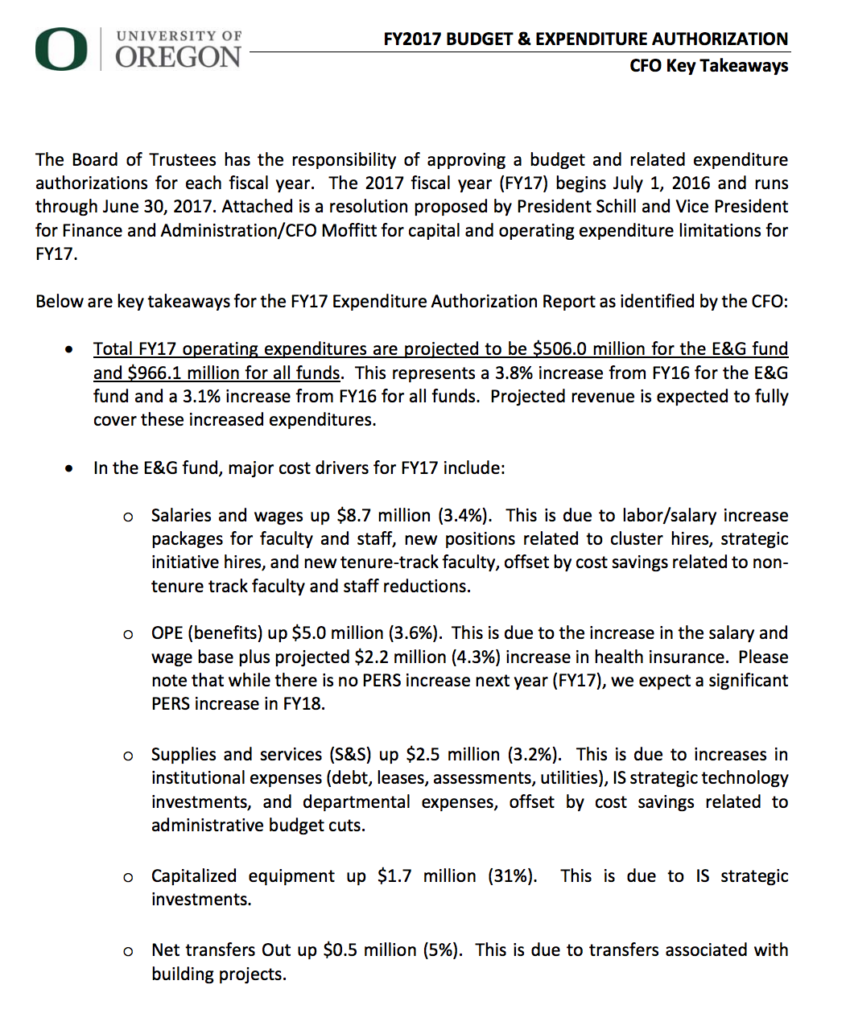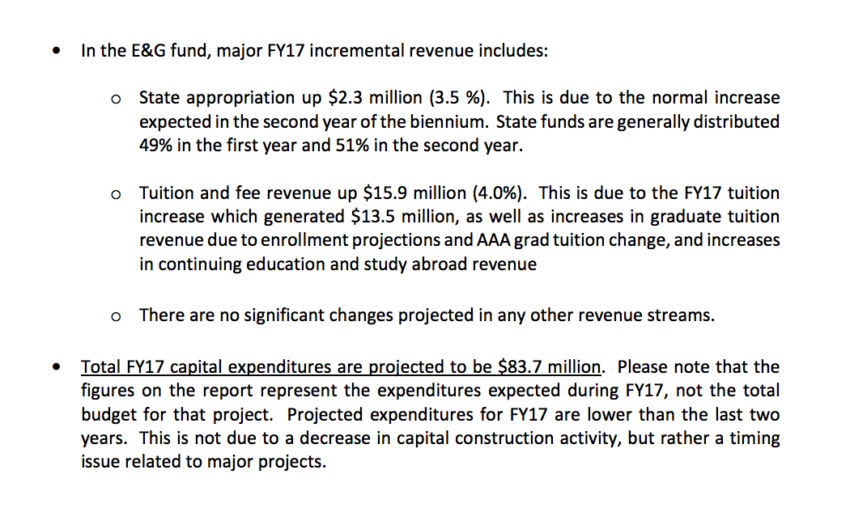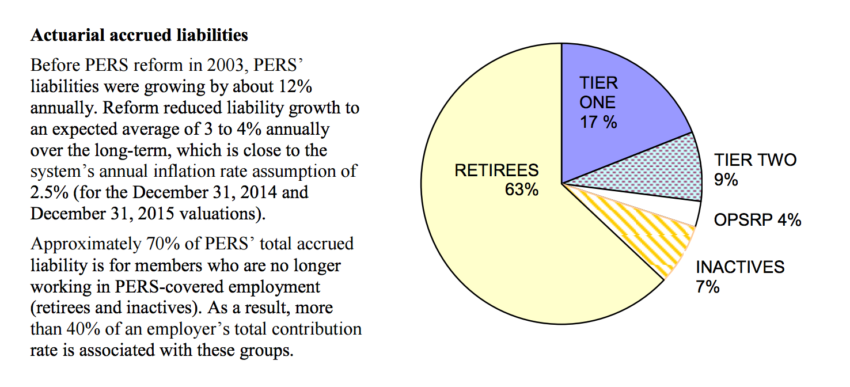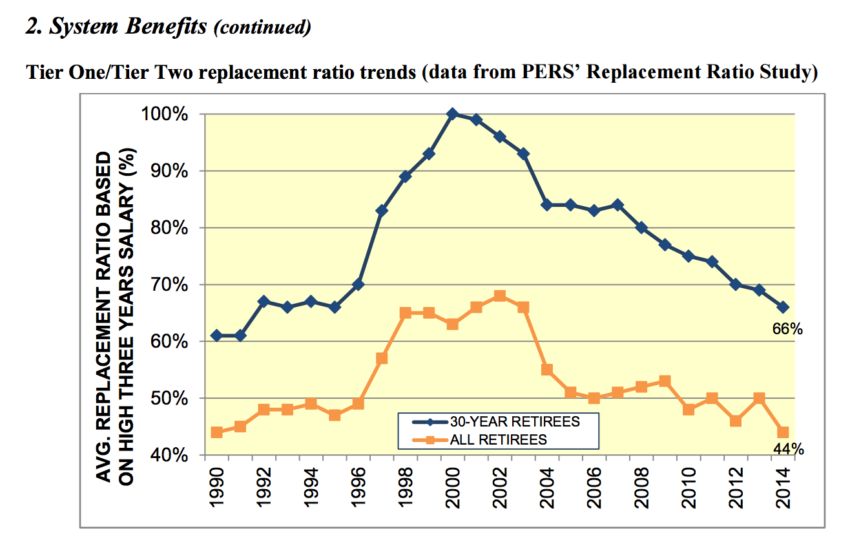Last updated on 08/16/2016
Update: A helpful commenter has pointed out to me that there is no short term deterioration in UO’s financial position. (The PERS threat on the other hand is real). The $17.5M shortfall claimed in the RG story for this year was already dealt with by the university administration, by this year’s tuition increases and spending cuts such as booting the 160over90 branders. This year’s budget is balanced.
I’m leaving up my incorrect post below, with the wrong parts xed out:
8/14/2016: Just 10 weeks ago UO’s CFO Jamie Moffitt told UO’s Board of Trustees:
Total FY17 operating expenditures are projected to be $506.0 million for the E&G fund and $966.1 million for all funds. This represents a 3.8% increase from FY16 for the E&G fund and a 3.1% increase from FY16 for all funds. Projected revenue is expected to fully cover these increased expenditures.
Today Diane Dietz reports in the RG that Jamie Moffitt says:
The UO forecasts total budget shortfalls of $17.5 million this fiscal year and $26.5 million the next.
For each additional $3 million needed — absent cutting costs or getting money from elsewhere [such as cutting subsidies to Duck tennis and baseball] — the UO must raise undergraduate tuition by one percentage point, Moffitt said.
In such a scenario, students may face a 6 percent increase this year and 9 percent the following year — and that’s only to keep up with the UO’s rising per-employee labor costs.
That doesn’t count other UO operating expenses, such as the $2.75 million the university says it needs to fix computer infrastructure or the $1.5 million it proposes to spend on hiring new, high-caliber faculty. [Or the ~$2.5M we spend on baseball, or the ~$1M we spend on softball, or the $2.5M we spend on the Jock Box, or the $500K we spent paying the former business school dean not to teach, or what we’re wasting in Portland, or …]
Moffitt’s full June 2nd 2016 report to the Board of Trustees is here:


Dietz’s story is correct that *future* UO budgets will be hit hard by new PERS increases (unless Measure 97 passes.) It is a little harder to understand that these increases are mostly needed to pay the costs of *past* retirees, because the state did not put enough money aside to fund their retirement while they were working. Now that burden is increasing the cost of *current* workers.
Ted Sickinger’s amazing 2011 story on how the people of Oregon came to be paying former Duck football coach Mike Bellotti $500K a year in pension benefits is here. In essence, Bellotti’s PERS payout was based on a calculation that included all the money he got in bonuses and Nike deals, even though UO never paid anything (or, taking note of comments from HUB, not much) from those payments into PERS. (This on top of the buyout deal he got after former UO GC Melinda Grier neglected to get a written contract for him, and then assistant GC Doug Park helped hide that from reporters.)
As Sickinger explained, a large part of the amount that state agencies (and UO) must pay for PERS isn’t going into investments that will support retirement costs for current workers, it’s going to pay current retirees, because the state agencies didn’t put in enough back when those retirees were working.
This situation has gotten worse. The PERS by the Numbers report for April 2016 notes that 40% of PERS costs now go to make up that deficit:

And this is despite the fact that PERS reforms have cut the amount of money that new retirees get to sensible levels:

But that’s not enough to put the system in balance, given the high payouts to earlier retirees. PERS is now only 71% funded, and the expectation is for a large new increase in how much UO and other state agencies will have to contribute. As Hubbard notes:
The latest calculations by the PERS actuary, released last week, showed that Oregon public agencies will have to shoulder an additional $885 million in pension costs in the 2017-19 biennium, a 44 percent increase.
Part of that increase was expected after the Oregon Supreme Court threw out some cost-curbing PERS changes in mid-2015. Those changes included a reduction in PERS cost-of-living increases, particularly on large pensions.
Just don’t make the mistake of counting those costs as a benefit to current workers, as VPFA Jamie Moffitt does.
Wouldn’t that be 6% this year and 3% the following year? Not that those are great numbers, just trying to get the math right here.
I see how you come up with that. I don’t think there’s enough info about the details to really get it straight. It may be that Diane Dietz has blown it.
In possibly related news, I have always wondered why there is not a coalition of large for-profit companies, local governments, and non-profit universities pushing for single-payer health care. It seems like most of the payroll-related expense increases that these entities incur are increases in the cost of health insurance coverage.
A major meltdown if true. It cannot all be due to PERS, either. The bills coming due for all those contracts with the various unions? Plus the nonunion staff, of course.
Time for Schill to put up or shut up, to put it bluntly. And the trustees.
Maybe it’s part of the plan to try to scare up more money from the legislature and support for the M97 tax plan. I wouldn’t count on that.
The students would be stupid to accept these kinds of tuition increases.
Across the board department cuts? Staff or pay, choose your poison.
I wonder what will come of the cluster plans?
I have to add: I wish the RG article had some indication for how and why this deficit for FY17 emerged, if the projection 10 weeks ago was that things looked to be in balance, with a reasonably good increase in revenue.
Since most of the revenue comes from tuition, I wonder if there has been a major drop in enrollment projections? This would have to be something like 1000 students. Admittedly, hard to believe it could be this big. But apart from that, I don’t see an explanation, unless the June budget projections were simply cooked or botched.
A story here that UO should explain, soon, very soon. If they are not forthcoming, I hope Diane Dietz, the UO senate will pry it out of them. What does the esteemed UO Senate Budget Committee have to say?
I’m surprised that Schill has allowed this to happen, and to become public so abruptly. His first major stumble, in my (ways humble!) opinion.
I will be waiting with bated breath, until I believe I understand what’s going on.
Dear Uncle,
I should not have used the word “shortfall”. I was trying to illustrate how much more the university has to produce each year to meet its labor costs.
If the U doesn’t find some other way to make things run rare even, tuition is (and has been) the recourse — and it takes a 1 percent increase to generate $3 million.
With tuition increases and cuts, Jamie says the budget was balanced for FY ’17
I probably should have concentrated on ’18 when the PERS comes due. Sorry for the confusion.
Diane
Thanks for the clarification, Honest Aunt Diane.
And also for your crucial role in convincing the administration to dump that “inane and insulting”, and expensive What the If branding campaign!
BTW, for those who haven’t been following this blog forever, Honest Uncle Bernie’s screen name originates from a post about Bernie Madoff years ago, and should not be taken to mean he is/was a Bernie Sanders supporter. Though he may be – I don’t know who he is.
The RG article states that “The Public Employees Retirement System’s benefit for long-standing workers — who belonged before 2003 — hinges on the system earning an unrealistic minimum investment return each year of 7.5 percent.” Shouldn’t that be 1996, since there’s no guarantee of an annual increase in the accounts of Tier 2 employees, those hired between 1996 and 2003? There are about 51000 active and inactive Tier 1 members but 68000 Tier 2 members.
That is good news, and a much better situation. The RG surely must do a followup story to clarify.
My humble apologies to Schill, Moffitt.
I wonder, then, what is the actual shortfall for fy 2018?
For the record, my screen name does probably allude to the Bernie who is in jail. Nothing to do with B. Sanders.
Glad that country club penitentiary has good wifi, Bernie.
me too, it gets mighty boring here, I have to scout around for sites like UOM to keep entertained and sane!
Hopefully this is strategic. I’ve long heard that good departments on campus get more resources by creating issues for deans to solve (they have to be solveable). Are they creating a need for state support to get more state support, and big time donor dollars? Or is this beginning of the end, where budget crunches happen, all the best faculty leave, and UO drops out of the AAU…
I think the state powers that be largely regard the UO as rich, and don’t see the reason to devote more money to it. Painting the need as being labor related appeals to the democratic powers that be.
I think the state has long considered UO to be able to draw in out of state money, and has allowed out of state enrollment to go to 50%, knowing that it gives them an out to be stingy with UO, even compared to the other campuses. Perhaps now OSU is milking the out of state dollar just as well as UO, I don’t know. But OSU has increased in state enrollment far more than UO, so the state is probably fine with it.
I hope Schill does not really think UO is going to get more out of the state for “research” and the “flagship” and the “AAU” university. Because they haven’t cared for 50 years, if they ever did, and it’s not going to change. If anything, the yahoos, bless their hearts, have always disliked UO for its perceived “elitism.” And yes, the perception is largely correct, and it’s not going to change. A lot of people still remember that programs at UO aimed at shutting down the timber industry when it was in its heyday.
Yes, UO is mostly on its own, for better or worse. Where are the big donors? I mean the really big donors.
So again I think comes back to framing. And they are framing the increase in costs as being driven by labor and unions, and are trying to get the legislature to buy into paying more for things democrats would usually support.
1. Unions
2. Benefits
3. Pensions
If they can get the state to swallow paying for some of those things, then they can use tuition for research or financial aid to attract better students.
I don’t know how long you’ve been in these parts, pardner, er, dude. I doubt that the legislature will see it that way — a bunch of elitist, pampered professora, to say nothing of the admin. But maybe I’m wrong about this?